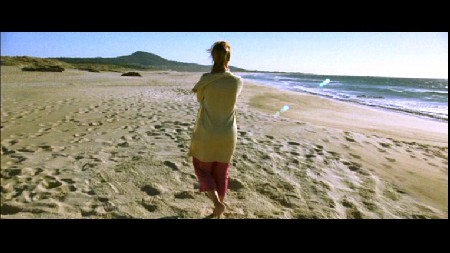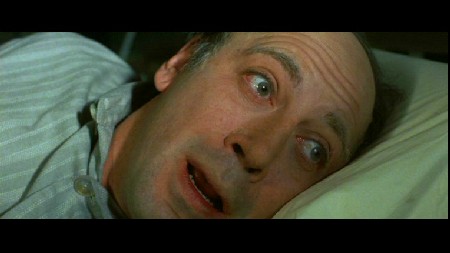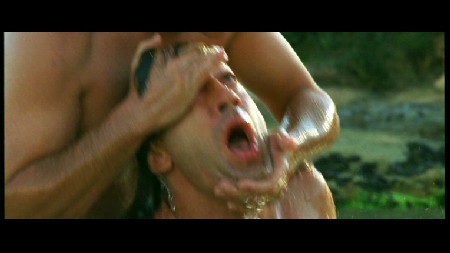 BUY IT AT AMAZON: CLICK HERE!
BUY IT AT AMAZON: CLICK HERE!
STUDIO: New Line Home Entertainment
MSRP: $27.95 RATED: PG-13
RUNNING TIME: 125 Minutes
SPECIAL FEATURES:
• Deleted Scenes
• Documentary "A Trip to the Sea Inside"
• Director’s commentary
• Storyboards, Photo and Set Design Galleries
• Theatrical Trailer
[Note from George: Some of the screen caps are mine. If you hate them, please direct your anger towards me and not David and his excellent review. Thank you!]
Earlier this year, the Terri Schiavo controversy catapulted one family’s decision of her daughter’s “right to die” straight into our living room televisions. No longer were such decisions under the ambit of private family matters; it was clear that they would now be fought on the national stage. Radical right-wing conservatives were allowed to hijack the Christian message. George W. Bush flew to Washington to sign a bill into law that would allow federal courts to intervene in the family’s medical decisions in this particular case. In essence, the government and media interceded where we never thought it could or would go. Terri Schiavo changed the national perception of how we view right-to-die cases and demonstrated the lengths to which our Republican-dominated government would go to broadcast its supposedly-Christian message to the world. If you haven’t formed an opinion on the subject yet, no doubt the recent events have at least forced you to confront your own worldview and explore your own thoughts on the matter.
With all this in mind, the DVD release of The Sea Inside could not be more timely. But like another Academy Award winning movie (I won’t give away which one it is, but hint: It has a BABY and a LARGE SUM OF MONEY in the title), it asks us deeper questions than Terri Schiavo’s situation could about what constitutes life. At what point is one’s life no longer worth living? And when does the person have a right to make that decision?
Based on the real-life story of Spaniard Ramon Sampedro, The Sea Inside depicts the life of a quadriplegic man who still has all his wits about him but insists that he should be given the right to die with dignity. Unlike Terri Schiavo, he isn’t in a persistent vegetative state, hence making the right-to-die issues much more complicated.
But is the film any good?

Wizened and full of experience, women who were members of the Sisterhood of the Traveling Hay Bales always had the craziest stories…
The Flick
Ramon Sampedro (Javier Bardem) used to be larger than life. In his twenties, he traveled around the world, bedding beautiful women and basically enjoying life to the fullest. Then a tragic diving accident left him paralyzed from the neck down. Consequently, he was forced to live with his brother, Jose (Celso Bugallo), and his wife and son, Manuela (Mabel Rivera) and Javi (Tamar Novas). Together, they took care of him for several decades, until he was well into his 50s.
In the meantime, Ramon didn’t just lie there idly. He designed a machine that would allow him to write with his mouth. He became a pseudo-head of the household, since all familial decisions needed to be based around him. He became a father-figure to Javi. But he also became convinced that life in this condition was not worth living and resolved to end it. He takes his cause to a woman named Gene (Clara Segura), who works at a right-to-die organization, and to Julia (Belen Rueda), an attorney struggling with her own debilitating illness. Together, they fight the government that’s resisting his efforts to have himself euthanized.
Seeing Ramon give an interview on TV, a woman named Rosa, who works at a local canning factory, is intrigued and goes to visit him to try to convince him to live. In actuality, Rosa has her own issues with life and love, and is subconsciously trying to work them up by talking with Ramon. Ramon is convinced that Rosa is judging her and their initial encounter ends badly. However, later their friendship grows and they end up falling in love. Julia also falls in love with Ramon even though she’s already married, creating a love triangle of sorts.
I could go on, but even though there’s plenty of plot and tons of stuff happening, the film didn’t feel story-driven nearly as much as it felt character-driven. Ramon is sweet, gregarious, charismatic, insightful, articulate, and inspiring. In spite of all this, in spite of the fact that he clearly has the influence to change people’s lives and to emotionally satisfy the women around him, he insists on being able to end his life. The film seems to challenge us to assent to this demand, yet doesn’t really give us the tools to do so in the sense that we taste very little of Ramon’s suffering. In fact, most of what is shown is how much of a positive effect he has on those around him, despite the fact that he no longer wants to live. Yet somehow, the film manages to also simultaneously have a clear message in affirming Ramon’s wishes regardless of everything else that’s going on. The legal plotline whereby Ramon is forced to defend his right to be euthanized is given some good mileage here, and we get the distinct feeling that we should be rooting for him to succeed in killing himself.

Shortly after its introduction to basic cable, Discovery Channel: Erotic Animal Planet enjoyed a meteoric rise to popularity.
Yet with all the talk of suicide and suffering, there is something beautiful about this film. While affirming the right to die with dignity, the film also left me with an overwhelming appreciation for living and for the beauty of the human experience. Sound cheesy? Well, so is the movie during several stretches. If you have a strong distaste for melodrama, then stay awawy. But if you’re willing to make some allowances for some sap and some soap opera-ish plot devices and dialogue, you’ll be rewarded with a film that takes you on a journey you won’t be able to forget.
Obviously, Javier Bardem’s performance is the one that’s the crux of the entire film. Bardem is absolutely convincing as a quadriplegic, making the most out of a role that requires him not to move and remain in the same position for whole scenes at a time. Facial expressions, mannerisms, and meaningful looks are basically the only tools he has, but he employs them masterfully, the result of endless hours of practice and research. The way Bardem portrays Ramon also gives him a magnetic charm that is absolutely irresistible. You wonder why he wants to kill himself even as you are challenged to believe that he should have the right to. If this is anything like the real-life Ramon Sampedro, it is very easy to see why as many as five (!) women fell for him during his time as a quadriplegic. The supporting actors and actresses are also stellar, and together their performances make the film truly memorable.
There are so many great moments in this film, most of them conveyed by simple gestures and startlingly genuine emotions. The look on Ramon’s face when he receives his book in the mail. The confrontation between Manuela and the quadriplegic priest. The embrace between Javi and Ramon at the end of the film. These scenes are moving and, using only actors, convey a humanity that’s hard to find in many feature films being released these days.

Peaceful… Serene… Melancholic… As are all moments prior to the gargantuan stomp of Gojira.
Director Alejandro Amenabar is well-known for thrillers such as The Others and Abre Los Ojos (which was remade into the unpleasant Vanilla Sky), so initially I was puzzled as to why he would choose to do what’s basically a melodrama. In the DVD features he explains some of his motivations, but regardless of what got into him, he brings an artistic flair to the film that a lesser director would not have been able to. Amenabar’s vision is what gives the film the gravitas to avoid becoming a Lifetime movie. The production values are high all around. The sets are convincing and the score (which Amenabar composed himself) is competent, though not as tear-jerking and technically masterful as a film like this might call for. Most of you will probably think that’s good, so I won’t hold that against the film.
Something that did occasionally bother me was the use of CGI and certain camera effects. Some digital effects are employed to complete the illusion that Bardem’s body has the physical build of a quadriplegic. These effects are almost unnoticeable and I thought they were quite well-done. However, other CGI shots of nature and weather effects were somewhat disconcerting to me. I understand what Amenabar may have been trying to do with these shots but they occasionally served to disturb me from the reality of the film, which Amenabar mentions in the commentary he did not want to have happen. One day we’ll have the technology to simulate photorealistic weather effects that are 100% believable. Until then, we’ll have to suffer through skilled but imperfect attempts.
Other than that, The Sea Inside is an emotionally powerful film that just may get you to reflect seriously on your own life. Any film that does that can only be a good thing.
8.8 out of 10
The Look

It wasn’t the sharting of his pants that bothered Jerevin Slaraci, but rather the terrifying realization that it would be permanently documented on message boards across the net.
A beautiful transfer. The film’s colors are brought to life by this transfer and there is nary a compression artifact to be found. Detail levels are great all around and colors are fairly vibrant all the way through. Due to the subject matter and setting, the filmmakers were going for more of an understated look with the color palette and the lighting so it’s not a particularly gorgeous film, but the transfer suits it quite well.
9.0 out of 10
The Noise
This sound mix is a little bit on the quiet side. Surround effects are good but somewhat inconsistent. In some scenes, you can clearly hear the roar of the sea at the beach, or some ambient forest noises in the rural setting. Other scenes you strain to hear something come out of anything but the center channel. The dialogue sounds fantastic though.
8.0 out of 10
The Goodies
The centerpiece of this set of special features is a featurette entitled The Sea Inside: A Journey (AKA A Trip to the Sea Inside). It is completely in Spanish, but subtitled. Made during the film’s production, this is basically an 80-minute long production diary, touching upon virtually every single aspect of the filmmaking. We meet Alejandro Amenabar, who looks really young (he’s in his early thirties) and seems like a really gentle yet brilliant man. The featurette then goes into the writing process, and we see Amenabar and Mateo Gil actually writing scenes that end up in the movie. I find these looks at the writing process endlessly fascinating, so I greatly enjoyed seeing them discuss different characters and scenes.

"Take me to a hospital! That little thing behind the bush… yeah, Linda Hunt… it ate my arm!"
"Sorry, this IS the hospital."
"Noooooooooooo!"
There is tons of behind-the-scenes footage included, and the featurette takes you through many of the film’s elements, from production design, to art direction, to set design. You really get a great appreciation for how much work went into making this film, which one could easily think is just a run-of-the-mill TV movie-of-the-week. Amenabar and his collaborators talk about tons of things that you don’t even think about during the movie: What’s the color scheme? How will the wardrobe colors affect the mood and believability for the film? This is a level of detail you expect for fairly big blockbusters, not for a drama. Nonetheless, all the work pays off in making a film that is great, equal if not exceeding the sum of its parts.
There are also lots of interviews with the various cast members including Bardem, who is shown researching the way paraplegics move and position themselves at the Toledo Hospital. He also had to learn how to write with his mouth for this role. Gotta love the dedication…
In short, this is one of the best behind-the-scenes featurettes I have ever seen, a documentary that enhances your appreciation of the film and also filmmaking in general. Highly recommended.
Alejandro Amenabar also gives a Full-length Director’s Commentary on the film. Again, it’s in Spanish with English subtitles. Amenabar’s enthusiasm is infectious; he never stops talking for the duration and provides many insights and anecdotes into the making of the film. There is actually not too much overlap with the documentary, as Amenabar seems to take pains to avoid repeating what’s already on the DVD. A great commentary track. Alejandro Amenabar is the man.

"Look! Another aneurism as a result of Brett Ratner!", exclaimed Brett Ratner.
There are three Deleted/Extended Scenes with a play all feature, (around 6 minutes long in total). The scenes fill in a lot of Julia’s back story and seem like they could’ve been put to good use in the film but Amenabar gives a good explanation in the commentary and featurette as to why they were excluded.
Photo Gallery is 32 images that are taken from the film or taken from the photos of Ramon’s life that you see used in the film itself, as Julia and Ramon talk about his past life while looking at them. Keep in mind that these are not photos of the actual Ramon, just Bardem playing them. There are photos from Ramon’s travels around the world. Some of them look really fake, with some obvious photoshopping, but from the production diary featurette, you see that a significant amount of work actually went into fabricating some of them.
Storyboard Gallery is a series of 32 black and white images which represent the storyboard sequence of Ramon’s diving accident. It’s interesting to see how much detail went into the planning of this short sequence.
Set Design Gallery is 17 color images of sketches of the film’s various sets and locations.
A theatrical trailer is included, as well as some bonus trailers from New Line films.
9.2 out of 10
The Artwork
Blue sea. Javier Bardem. A good amount of text.
The blue color scheme is nice, and the film IS about Javier Bardem’s character. Other than that, this is fairly unimpressive as art and really tells you nothing about the film (other than indicating its sea-related theme).
6.0 out of 10

"And THIS is for claiming Sith was better than Empire!"